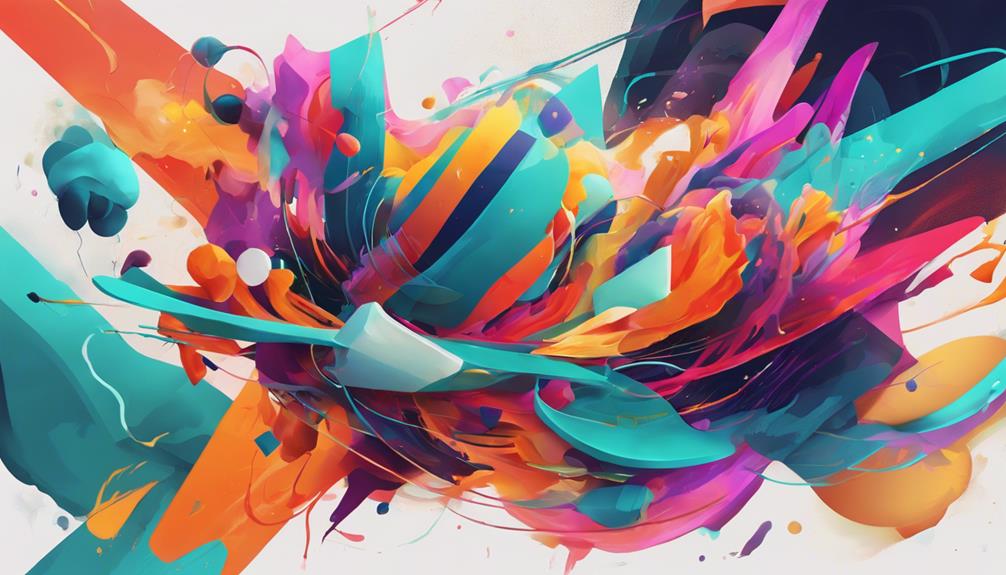Abstract art, a genre that has captivated and puzzled viewers for decades, challenges the traditional notion of art as a mirror of reality. Delving into the realms of form, color, and line, abstract art invites contemplation and interpretation. By stripping away the direct representation of objects, abstract artists create a unique language of shapes and colors that communicate on a different level. This departure from the tangible world opens a door to a multitude of meanings and emotions, inviting viewers to explore the depths of artistic expression in a way that transcends the confines of the physical.
Key Takeaways
- Abstract art challenges traditional norms through spiritual and emotional expression.
- Evolution from representational styles to experimental forms and unconventional techniques.
- Abstract art encourages individual expression, exploration of intangible concepts, and innovative approaches.
- Impactful on modern art, abstract art shapes artistic trends, techniques, and societal perspectives.
Origins of Abstract Art
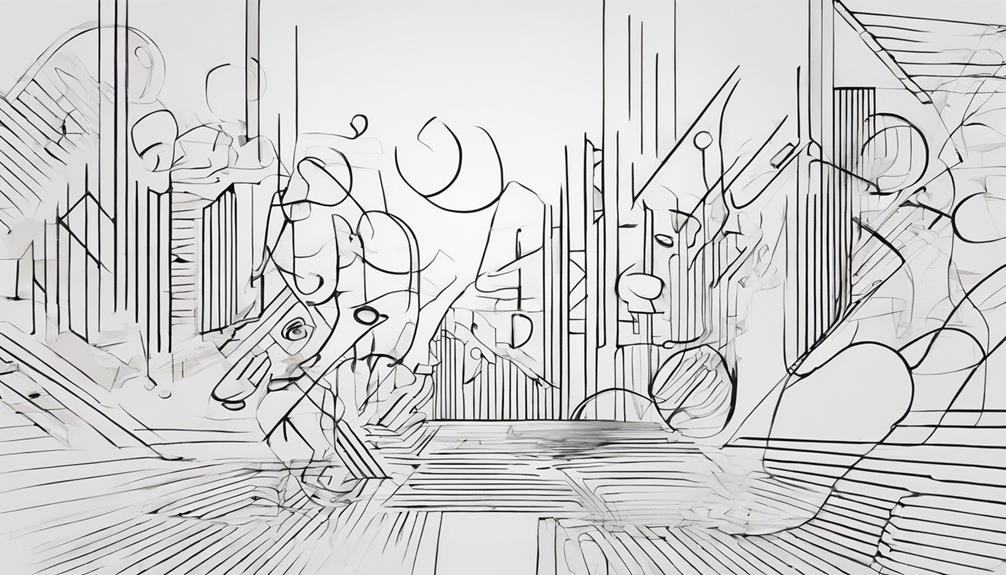
Abstract art, originating in the early 20th century, marked a significant departure from conventional depictions of the physical world. Pioneers such as Wassily Kandinsky and Hilma af Klint played pivotal roles in the development of abstract art. Kandinsky, with works like 'Komposition V' in 1911, emphasized the importance of spiritual and emotional expression in art. Similarly, Hilma af Klint, though her abstract art went unrecognized until 1986 due to her reluctance for publicity, also delved into spiritual themes in her work. The origins of abstract art can be traced back to the early 20th century movements like Fauvism, Cubism, and the Russian Experiment in Art. These movements laid the groundwork for artists to break away from representational art and explore new forms of expression. The pioneering works of Kandinsky and af Klint set the stage for the evolution of abstract painting into a diverse and influential art form.
Evolution of Abstract Painting
The progression of abstract painting throughout the early 20th century marked a decisive shift away from traditional representational art styles.
- Pioneers: Artists like Wassily Kandinsky and Hilma af Klint introduced early abstract concepts, challenging the norms of art representation.
- Techniques: Kazimir Malevich and Piet Mondrian furthered the development of abstract painting by exploring geometric forms and simplification of compositions.
- Colors: The evolution in the use of colors became a central focus in abstract painting, with artists experimenting with bold and unconventional color palettes to evoke emotions and reactions.
- Expressions: Artists like Jackson Pollock and Cy Twombly revolutionized abstract painting by introducing new techniques like action painting and calligraphic gestures, allowing for a more emotional and spontaneous form of expression.
These pioneers and innovators paved the way for contemporary artists to continue pushing the boundaries of abstract art, exploring new forms, colors, and expressions in the ever-evolving landscape of artistic creation.
Understanding Abstract Expressionism

Emerging in the 1940s in New York City, Abstract Expressionism stands as a prominent art movement influenced by surrealism, with key figures such as Jackson Pollock and Mark Rothko at its forefront. This artistic movement is characterized by its emphasis on emotional depth, spontaneity, and individual expression. Abstract Expressionist artists sought to convey raw emotions and intense energy through their work, often using techniques that involved gestural brushstrokes and dynamic compositions. The spontaneity in their process allowed for a direct connection between the artist's inner feelings and the artwork produced.
Even in contemporary art, artists like Matthew Dibble and Jay Meuser continue to draw inspiration from Abstract Expressionism, pushing the boundaries of traditional artistic norms. By prioritizing individual expression and focusing on the emotional impact of their creations, these artists carry on the legacy of Abstract Expressionism in a modern context. This movement remains a significant influence in the art world, reminding viewers of the power of raw emotion and personal interpretation in art.
Exploring Abstract Photography
In the realm of contemporary art exploration, abstract photography emerges as a captivating medium that mirrors the essence of abstract art through innovative techniques and perspectives. Abstract photography, much like abstract art, relies on creative manipulation of elements such as light, shadow, and composition to create visually engaging images. Photographers like Barbara Crane are known for distorting traditional cityscapes using close-ups and overexposure, transforming mundane scenes into abstract wonders. Kimberly Poppe, on the other hand, draws inspiration from abstract expressionism to create artistic compositions from landscapes, adding depth and emotion to her work. The abstraction in photography allows for unique interpretations, challenging viewers to see ordinary subjects in a new light, much like the experience of viewing abstract art. Through the lens of abstract photography, everyday objects and scenes are transformed into thought-provoking visual narratives, inviting viewers to explore the boundaries of perception and creativity.
Notable Abstract Artworks
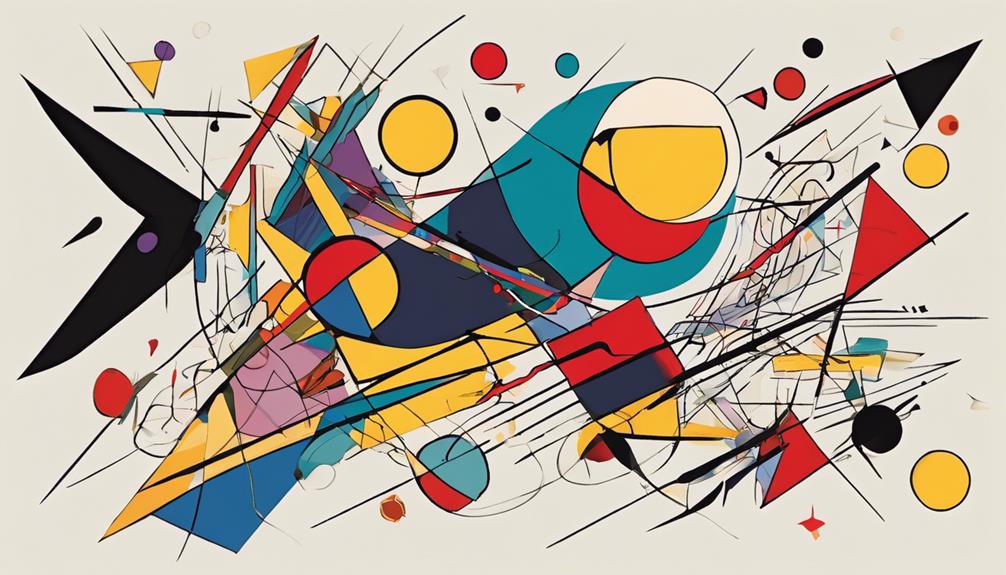
In the exploration of notable abstract artworks, it is essential to consider their influence on the evolution of abstraction and their impact on viewers. These artworks, such as Kandinsky's 'Composition VII' and Malevich's 'Black Square', have played pivotal roles in shaping the trajectory of abstract art, challenging conventional artistic norms and pushing boundaries of creativity. By analyzing the innovative techniques and conceptual depth of these works, one can gain a deeper understanding of the profound impact abstract art has had on the art world and society as a whole.
Influential Abstract Art
Highlighting the evolution and impact of influential abstract artworks, notable pieces by renowned artists have significantly shaped the trajectory of abstract art throughout history.
- Kazimir Malevich's 'Dynamic Suprematism' (1915 or 1916) exemplifies pure abstraction.
- Theo van Doesburg's 'Counter-Composition VI' (1925) emphasizes geometric abstraction.
- Naum Gabo's 'Construction in Space ‘Two Cones' (1927) is a pioneering work in abstract sculpture.
- Morris Louis' 'Alpha-Phi' (1961) and Joan Miró's 'Painting' (1927) represent distinct styles and approaches within abstract art.
These artworks by Malevich, van Doesburg, Gabo, Louis, and Miró have played crucial roles in shaping the diverse landscape of abstract art, showcasing the richness and innovation of the genre.
Evolution of Abstraction
The progression of abstraction in art history unfolds through a series of pivotal moments marked by groundbreaking works that redefine artistic expression. Orphism by Guillaume Apollinaire in 1912–13, Wassily Kandinsky's 'Cossacks' (1910–1), Juan Gris' 'Bottle of Rum and Newspaper' (1913–14), Kazimir Malevich's 'Dynamic Suprematism' (1915 or 1916), and Theo van Doesburg's 'Counter-Composition VI' (1925) all played significant roles in the evolution of abstract art. These works showcased the transition from early abstract painting to the exploration of pure abstraction and geometric principles. Below is a table highlighting some of these notable abstract artworks:
| Artist | Artwork |
|---|---|
| Guillaume Apollinaire | Orphism |
| Wassily Kandinsky | 'Cossacks' |
| Juan Gris | 'Bottle of Rum and Newspaper' |
Impact on Viewers
Abstract art, with its diverse range of notable artworks, has the capacity to elicit varied emotional responses and interpretations from viewers, prompting profound introspection and personal contemplation.
- Abstract art can evoke different emotions and interpretations in viewers, sparking introspection and personal reflection.
- Notable abstract artworks like Jackson Pollock's 'No. 5, 1948' challenge traditional notions of art, inviting viewers to explore the depths of their own perceptions.
- Through works like Mark Rothko's 'Orange, Red, Yellow,' abstract art can create a powerful visual experience that transcends language and cultural barriers.
- The impact of Piet Mondrian's 'Composition II in Red, Blue, and Yellow' lies in its ability to engage viewers through its dynamic use of color and geometric forms.
Trends in Abstract Art
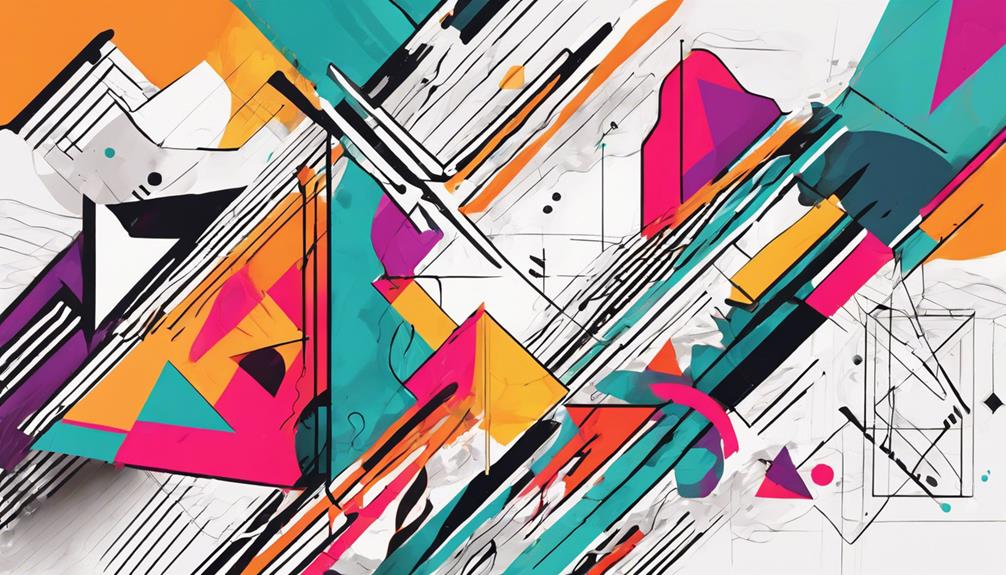
Abstract art has been shaped by various trends over time, reflecting the evolution of artistic expression. From the minimalist approach to the integration of technology and cultural diversity, these trends offer insights into the current landscape of abstract art. Understanding these influences can provide valuable context for appreciating the works of influential abstract artists and the innovative creations emerging in contemporary abstract art.
Evolution of Abstract Art
Evolution of abstract art in the early 20th century witnessed a transformative shift from traditional representational styles towards more innovative and conceptual approaches.
- Exploration of Form: Artists began to experiment with breaking down and reimagining traditional forms, leading to the emergence of new shapes and structures.
- Play with Color: The use of color evolved from representing reality to conveying emotions and concepts, pushing the boundaries of traditional color palettes.
- Conceptual Approaches: Artists delved into the realm of ideas and philosophies, seeking to express intangible concepts through visual means.
- Minimalistic Tendencies: A trend towards simplification and reduction emerged, focusing on the essence of art rather than intricate details.
Influential Abstract Artists
The exploration of influential abstract artists within the realm of abstract art reveals a diverse array of creative expressions that have significantly shaped the trajectory of artistic innovation and experimentation. Wassily Kandinsky stands out as a pioneer with his groundbreaking work 'Composition V' (1911), which played a key role in popularizing abstract art. Hilma af Klint, a lesser-known figure, made her mark by creating abstract paintings as early as 1906, predating Kandinsky's breakthrough. Piet Mondrian's geometric abstraction, Kazimir Malevich's pure abstract style, and Naum Gabo's abstract sculptures have also left lasting impressions on the trends in abstract art. These influential artists, along with others like Joan Miró, Morris Louis, and Theo van Doesburg, have collectively contributed to the rich tapestry of abstract art evolution.
Contemporary Abstract Art
Contemporary abstract art in the current artistic landscape displays a notable shift towards more experimental and unconventional techniques. Artists are exploring unconventional mediums like digital art and installations. The use of vibrant colors, dynamic textures, and bold compositions is prevalent, creating visually striking pieces. Social and political themes are being incorporated, adding layers of meaning to the artwork. Collaboration and interdisciplinary approaches are becoming more common, leading to innovative and diverse creations. This trend showcases a departure from traditional artistic norms, embracing geometric shapes and unconventional materials to push the boundaries of abstract art further into the realm of creativity and expression.
Impact of Abstract Art
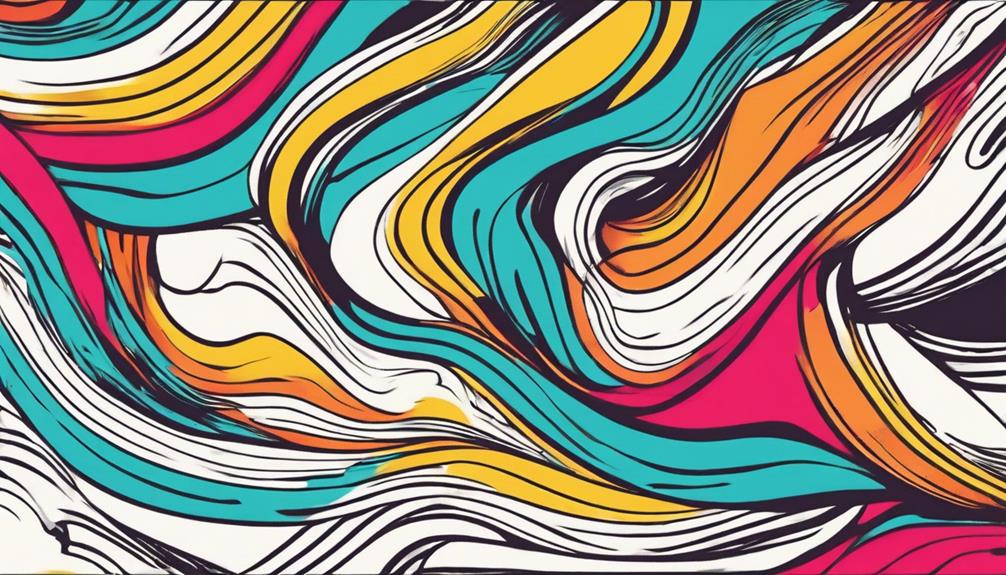
Abstract art has wielded a profound influence on the trajectory of modern art, challenging conventional artistic norms and paving the way for innovative expressions. By breaking away from the constraints of realistic representation, abstract art opened doors to a realm where interpretations and emotions could flow freely. This departure from traditional norms allowed artists to explore themes such as order and spirituality in ways that pure abstract pioneers like Kazimir Malevich and Piet Mondrian exemplified. The impact of pure abstract painting, emerging between 1910-20, marked a pivotal moment in art history, emphasizing the beauty found in geometry over literal depictions. This shift not only revolutionized artistic techniques but also encouraged viewers to engage with art on a deeper, more personal level. The legacy of abstract art continues to inspire new generations of artists to experiment, innovate, and challenge the boundaries of creativity in the modern art world.
Abstract Art in Modern Times
Exploring the evolution of artistic expression in modern times, how has abstract art transcended conventional boundaries to encompass a diverse array of styles, techniques, and mediums? In contemporary art scenes, abstract art has flourished, embracing a multitude of innovative approaches and pushing the boundaries of traditional artistic norms. Modern abstract artists are constantly experimenting with unconventional materials, integrating digital technologies, and exploring interdisciplinary methods to create unique and thought-provoking pieces. The exploration of complex themes, personal narratives, and social issues has become a common thread in contemporary abstract art, reflecting the diverse perspectives of artists in the modern era. Additionally, abstract art in the digital age has seen a significant transformation with the incorporation of new technologies such as virtual reality, augmented reality, and interactive installations, offering viewers immersive and interactive artistic experiences.
- Modern abstract artists experiment with unconventional materials and techniques.
- Contemporary abstract art explores complex themes and social issues.
- Abstract art in the digital age incorporates new technologies like virtual reality.
- Artists continue to push boundaries and redefine the possibilities of artistic expression.
Resources for Learning More
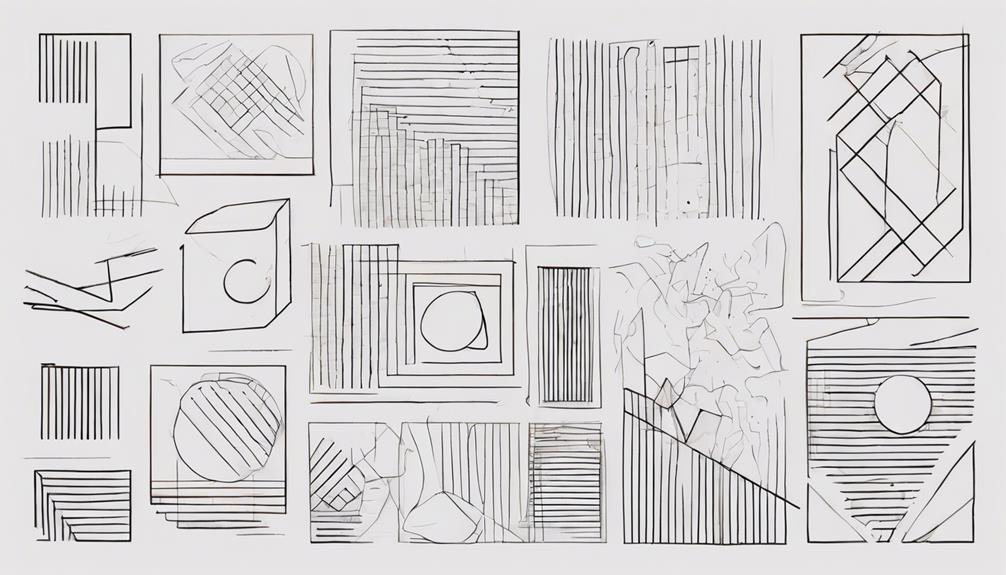
The study of resources available for further understanding abstract art provides valuable insights into the historical significance, diverse interpretations, and evolving methodologies within this genre of artistic expression. Abstract art, with its focus on distilling visual elements into non-representational forms, offers a unique avenue for pure aesthetic expression. To delve deeper into this fascinating world, exploring the works of key figures like Wassily Kandinsky and Hilma af Klint can provide profound insights into the origins and evolution of abstract art. Geometric abstraction, a prominent style within abstract art, showcases the precision and mathematical beauty that can be achieved through art. Below is a table highlighting some essential resources for learning more about abstract art:
| Resource | Description | Benefits |
|---|---|---|
| Art History Books | Provide in-depth analyses of abstract art movements | Historical context and critical insights |
| Online Art Galleries | Showcase a wide range of abstract artworks | Access to diverse styles and interpretations |
| Museum Exhibitions | Display renowned abstract art pieces | Experience art in person and learn from curated collections |
Frequently Asked Questions
What Is the Meaning of Abstract in Art?
In the realm of art, the term 'abstract' denotes a departure from realistic representation, emphasizing emotional expression and creative interpretation over tangible depictions. Artists employ non-representational forms, color theory, and spatial relationships to construct visual language that transcends literal meaning. This approach offers artistic freedom, enabling the conveyance of intricate ideas solely through abstract elements, encouraging viewers to engage with the artwork subjectively and experience diverse personal interpretations.
What Are 3 Characteristics of Abstract Art?
Abstract art is characterized by color harmony, emotional expression, and geometric shapes. Artists often use texture contrast to create depth and movement illusion, fostering visual interpretation. The spontaneity in creating abstract works allows for a range of emotions and ideas to be conveyed through non-representational means. These characteristics challenge viewers to engage with art on a subjective level, inviting personal interpretation and reflection.
What Is Abstract Art Described As?
Abstract art is described as a form of artistic expression that emphasizes emotional interpretation, visual exploration, and creative freedom. It utilizes symbolic representation, subjective perception, and unique perspective to challenge traditional norms and expand the boundaries of art. By focusing on shapes, colors, and forms rather than recognizable objects, abstract art allows for a deeper exploration of visual language and invites viewers to interpret and engage with the artwork on a personal level.
What Is the Aim of Abstract Art?
The aim of abstract art is to explore creativity by pushing boundaries and challenging norms. It seeks to express emotions, capture essence, and evoke feelings through non-representational means. By inspiring interpretation, abstract art engages the viewer's imagination and encourages personal reflection. Through its unique approach, abstract art invites individuals to delve into the depths of their own perceptions and interpretations, fostering a deeper connection between the artwork and the observer.
Conclusion
In conclusion, abstract art emerged in the early 20th century as a form of artistic expression that prioritizes form, color, and line over direct representation of the physical world. This movement has evolved over time, challenging traditional artistic conventions and allowing for diverse interpretations. For example, Piet Mondrian's "Composition with Red, Blue, and Yellow" exemplifies the use of geometric shapes and primary colors to evoke emotion and convey meaning in abstract art.
